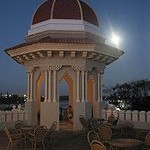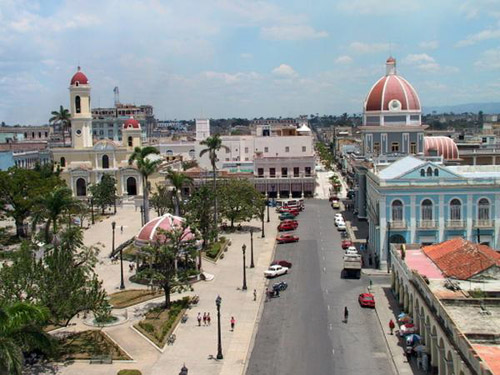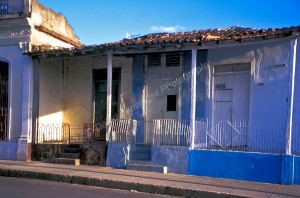THE CITY OF CIENFUEGOS, CUBA, BETTER KNOWN AS “PEARL OF THE SOUTH”.
Cienfuegos is a city on the southern coast of Cuba, capital of Cienfuegos Province. It is located about 250 km (160 mi) from Havana, and has a population of 150,000. The city is dubbed La Perla del Sur (Pearl of the South). Cienfuegos literally translates to “Hundred fires”.
The area was called the Cacicazgo de Jagua by the early Spaniards, and was settled by indigenous people.
Located in The South coast of the central region of Cuba, Cienfuegos has a singular history which is present in the Castle of Our Mother of Los Angeles of Jagua, a fortress erected in 1745 for protection against Caribbean pirates which is loaded of legend for 250 years has been the only access defending the best sea to one of bays of raft of The Hispanic America. Their excellence as far as depth, defense and the inner presence of keys and coves turned the bay into a refuge against storms of the Caribbean Sea for the navigators of long ago the City of Cienfuegos, capital of the province with the same name, was designed in its definitive layout by French colonos in 1819.
Those pioneers coming from Bordeaux and La Luisiana, led by Don Louis de Clouet, on April 22, 1819. Its original name was Fernardina de Jagua, in honor of Ferdinand VII of Spain. The settlement became a town (Spanish: Villa) in 1829, and a city in 1880. The city was subsequently named Cienfuegos, sharing the name with Cienfuegos, a Captain General in this time, in the island which laid the urbanistic foundations of civil architecture that gives singularity to the city, and attest their refinement. The perfect layout of their streets, harmonically conjugated with multiple constructions and other elements of high architectural value, reveals the splendor of a cosmopolitan culture with a strong French accent, and allows the visitor to breathe the neoclassic atmosphere that distinguishes this large city, raised at the border of a bay of strongly rooted marine traditions, in a region also equipped with innumerable natural attractiveness and a vast culinary culture.
Cienfuegos, one of the chief seaports of Cuba, is a center of the sugar trade, as well as coffee and tobacco. While sugarcane is the chief crop, local farmers grow coffee.
The downtown contains 6 buildings from 1819–50, 327 buildings from 1851–1900, and 1188 buildings from the 20th century. There is no other place in the Caribbean which contains such a remarkable cluster of Neoclassical structures.
In 2004, the municipality of Cienfuegos had a population of 163,824. With a total area of 333 km2 (129 sq mi), it has a population density of 492.0 /km2 (1,274 /sq mi).
Near Cienfuegos was the scene of a battle on May 11, 1898, between American marines who attempted to sever underwater Spanish communication lines and the Spanish defenders.
During the Cuban Revolution the city saw an uprising against Fulgencio Batista and was bombed, on September 5, 1957.
In 2005, UNESCO inscribed the Urban Historic Centre of Cienfuegos on the World Heritage List, citing Cienfuegos as the best extant example of the 19th-century early Spanish Enlightenment implementation in urban planning.
In 2005, Hurricane Dennis made its second landfall near Cienfuegos at about 1:00PM AST (17:00 UTC) with winds of 232 km/h (144 mph), and gusts reaching 285 km/h (177 mph).
One of the turrets on the moonlit roof of Palacio de Valle

Castillo de Nuestra Señora de los Ángeles de Jagua – fortress
Arco de Triunfo – the only Arco de Triunfo in Cuba
Cathedral de la Purisma Concepción – cathedral with stained glass work, built 1833-1869.
Delfinario – dolphins and sea lions in a saltwater lagoon
Jardín Botánico de Cienfuegos – 97 hectares of botanic garden
Museo Provincial – furniture and porcelain museum
Palacio de Valle – built 1913–1917 in neo-gothic style
Palmira Yorubá Pantheon – museum of religious afro-catholic syncretism
Parque José Martí – park in Plaza de Armas
University of Cienfuegos “Carlos Rafael Rodríguez” (UCF) – the province’s secondary education institution.
Famous residents
Benny Moré, Cuban singer.
Cristóbal Torriente, Cuban-born Hall of fame Baseball player.
Gina Pellón, Cuban painter, lives in exile in Paris.
María Conchita Alonso, Cuban-Venezuelan-American singer was born here.
Luis Posada Carriles, Cuban anti-Castro commando was born here.
Joe Azcue, MLB player for the Cincinnati Reds, Kansas City Athletics, Cleveland Indians, Boston Red Sox, California Angels, and the Milwaukee Brewers.
Agencies/Wiki/Internet Photos/Arnoldo Varona/ TheCubanHistory.com
THE CUBAN HISTORY, HOLLYWOOD.
FOLLOW US ON TWITTER AND FACEBOOK. THECUBANHISTORY.COM
LA CIUDAD DE CIENFUEGOS, CUBA, MÁS CONOCIDA COMO “LA PERLA DEL SUR”.
Cienfuegos es una ciudad en la costa sur de Cuba, capital de la provincia de Cienfuegos. Se encuentra a unos 250 kilómetros (160 millas) de La Habana, y tiene una población de 150.000 habitantes. La ciudad se llamó La Perla del Sur (Perla del Sur). Cienfuegos se traduce literalmente como “Cienfuegos”.
El área fue llamada el cacicazgo de Jagua por los primeros españoles, y fue fundada por los pueblos indígenas.
Situado en la costa sur de la región central de Cuba, Cienfuegos tiene una historia singular que está presente en el Castillo de Nuestra Señora de Los Ángeles de Jagua, una fortaleza construida en 1745 para la protección contra los piratas del Caribe, que se carga de la leyenda de 250 años ha sido la única defensa de los mejores del mar hasta una de las bahías de bolsa de la América hispana. Su excelencia en cuanto a profundidad, la defensa y la presencia interior de las llaves y calas de la bahía se volvió en un refugio contra las tormentas del Mar Caribe para los navegantes de antaño de la ciudad de Cienfuegos, capital de la provincia con el mismo nombre, diseñado se en su trazado definitivo por colonos franceses en 1819.
Aquellos pioneros procedentes de Burdeos y La Luisiana, dirigida por Don Luis de Clouet, el 22 de abril de 1819. Su nombre original era Fernardina de Jagua, en honor de Fernando VII de España. El asentamiento se convirtió en una ciudad (en español: Villa) en 1829, y una ciudad en el año 1880. La ciudad fue nombrada posteriormente Cienfuegos, compartiendo el nombre con el Cienfuegos, capitán general en este momento, en la isla, que sentó las bases urbanísticas de la arquitectura civil que le da singularidad a la ciudad, y doy fe de su refinamiento. El diseño perfecto de sus calles, armónicamente conjugados con múltiples construcciones y otros elementos de gran valor arquitectónico, revela el esplendor de una cultura cosmopolita, con un fuerte acento francés, y permite al visitante respirar el ambiente de estilo neoclásico que distingue a esta gran ciudad, planteada en el borde de una bahía de tradiciones fuertemente arraigadas marinos, en la región también cuenta con atractivos innumerables natural y una gran cultura culinaria.
Cienfuegos, uno de los principales puertos marítimos de Cuba, es un centro del comercio del azúcar, así como café y tabaco. Mientras que la caña de azúcar es el principal cultivo, los agricultores locales cultivan café.
El centro consta de 6 edificios de 1819-50, 327 edificios de 1851-1900, y 1188 de los edificios del siglo 20. No hay otro lugar en el Caribe, que contiene un notable conjunto de estructuras neoclásicas.
En 2004, el municipio de Cienfuegos, tenía una población de 163.824. Con una superficie total de 333 km2 (129 millas cuadradas), tiene una densidad poblacional de 492,0 / km 2 (1.274 / km ²).
Cerca de Cienfuegos fue el escenario de una batalla el 11 de mayo de 1898, entre los infantes de marina estadounidenses que intentaron romper las líneas de comunicación españoles bajo el agua y los defensores españoles.
Durante la Revolución Cubana, la ciudad vio un levantamiento contra Fulgencio Batista y fue bombardeada, el 5 de septiembre de 1957.
En 2005, la UNESCO inscribió al Centro Histórico Urbano de Cienfuegos en la Lista del Patrimonio Mundial, citando a Cienfuegos como el mejor ejemplo existente del siglo 19 la pronta aplicación Ilustración española en la planificación urbana.
En 2005, el huracán Dennis hizo a tocar tierra cerca de Cienfuegos a unos AST 13:00 (17:00 UTC), con vientos de 232 km / h (144 mph) y ráfagas que llegan a 285 kmh (177 mph).
One of the turrets on the moonlit roof of Palacio de Valle
Castillo de Nuestra Señora de los Ángeles de Jagua – fortress
Arco de Triunfo – the only Arco de Triunfo in Cuba
Cathedral de la Purisma Concepción – cathedral with stained glass work, built 1833-1869.
Delfinario – dolphins and sea lions in a saltwater lagoon
Jardín Botánico de Cienfuegos – 97 hectares of botanic garden
Museo Provincial – furniture and porcelain museum
Palacio de Valle – built 1913–1917 in neo-gothic style
Palmira Yorubá Pantheon – museum of religious afro-catholic syncretism
Parque José Martí – park in Plaza de Armas
University of Cienfuegos “Carlos Rafael Rodríguez” (UCF) – the province’s secondary education institution.
RESIDENTES FAMOSOS
Benny Moré, la cantante cubana.
Cristóbal Torriente, nacido en Cuba, del Salón de la Fama del Béisbol.
Gina Pellón, pintor cubano, vive en el exilio en París.
María Conchita Alonso, cubano-venezolano-americano cantante nació aquí.
Luis Posada Carriles, el cubano anticastrista comando nació aquí.
Joe Azcue, jugador de MLB para los Rojos de Cincinnati, Atléticos de Kansas City, los Indios de Cleveland, Medias Rojas de Boston, Angelinos de California, y los Cerveceros de Milwaukee.
Agencies/Wiki/Internet Photos/Arnoldo Varona/ TheCubanHistory.com
THE CUBAN HISTORY, HOLLYWOOD.








